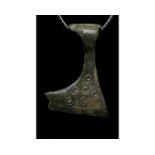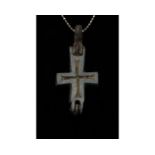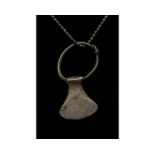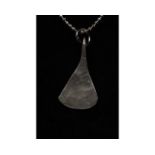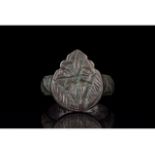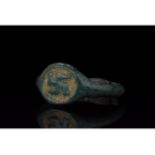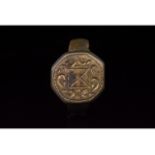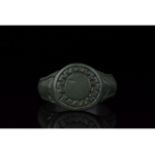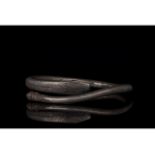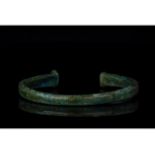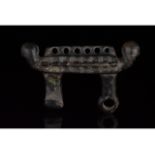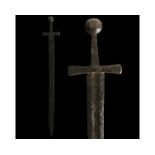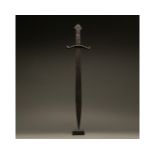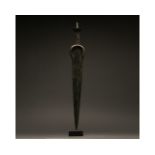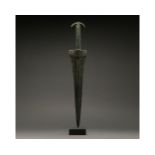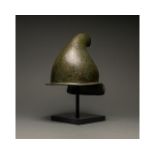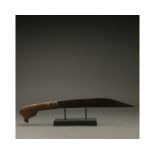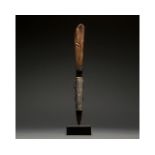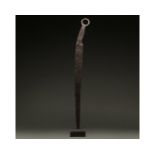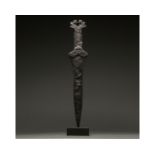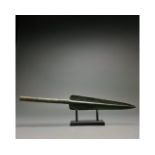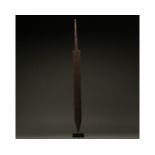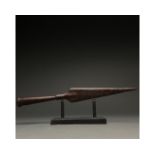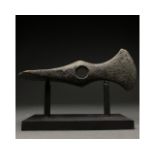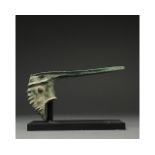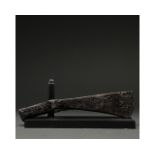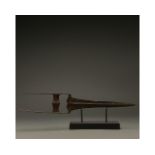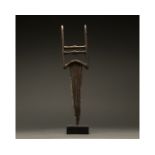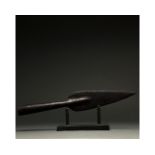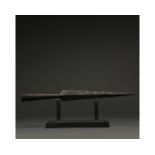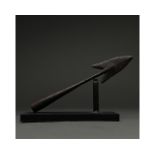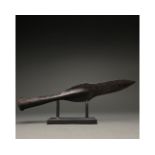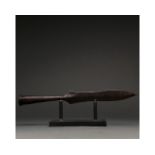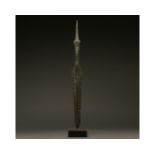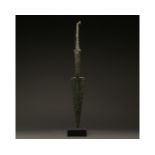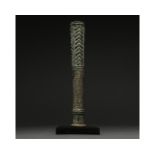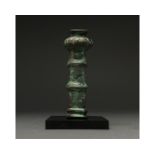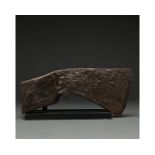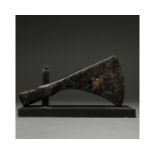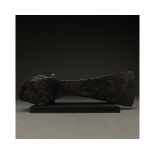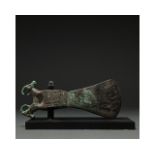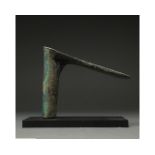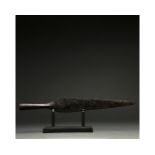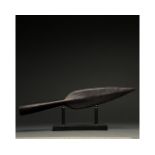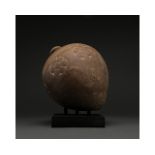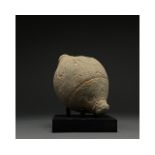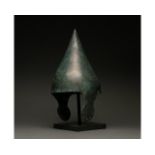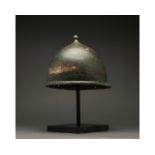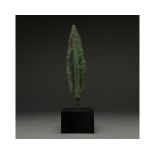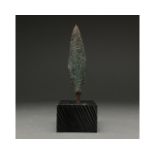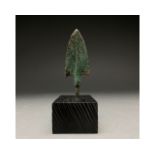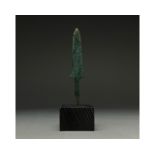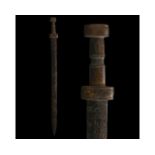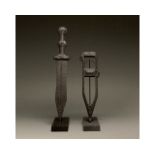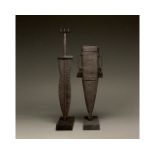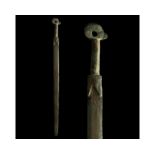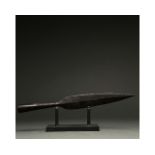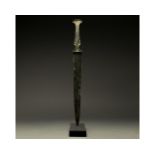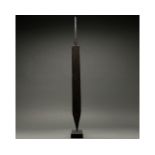Refine your search
Estimate
Category
- Arms, Armour & Militaria (180)
- Jewellery (118)
- Greek, Roman, Egyptian & Other Antiquities (86)
- Chinese Works of Art (55)
- Scientific Instruments (33)
- Sculpture (24)
- Collectables (20)
- Coins (19)
- Ceramics (13)
- Salvage & Architectural Antiques (8)
- Vintage Fashion (8)
- Glassware (7)
- Bank notes (6)
- Islamic Works of Art (6)
- Metalware (6)
- Books & Periodicals (5)
- Models, Toys, Dolls & Games (3)
- Textiles (3)
- Classic Cars, Motorcycles & Automobilia (2)
- Musical Instruments & Memorabilia (2)
- Wines & Spirits (2)
- Clocks (1)
- Kitchenalia (1)
- Silver & Silver-plated items (1)
Filtered by:
- Item Type
- List
- Grid
A subscription to the Price Guide is required to view results for auctions ten days or older. Click here for more information
1000-1500 AD, Crusader Period. Nice silver seal ring with D-shaped loop, decorated shoulders and circular bezel bearing an abstract Christian mono...
LARGE VIKING BRONZE AXE PENDANT
700-1100 AD, Viking Age. A bronze example of an axe or Perun amulet comprising a suspension loop and a stylised axe with a notched head, and impre...
1000-1500 AD, Crusader Period. A bronze double reliquary cross with suspension loop from which hangs a box in the form of a cross with rectangular...
700-1100 AD, Viking Age. A silver example of an axe or Perun amulet comprising a large suspension loop and a stylised axe head. This type of amule...
700-1100 AD, Viking Age. A silver example of an axe or Perun amulet comprising a suspension loop and a stylised axe head. This type of amulet is m...
1000-1500 AD. Crusader period. A silver heraldic ring with a circular hoop with a raised circular boss at the bottom and a shield-shaped plate bez...
700-1100 AD. Viking Age. A bronze ring comprising a circular hoop featuring overlapping terminals and a rounded plate bezel with a swastika in low...
1100-1300 AD, Medieval. Bronze ring with D-shaped hoop and flattened, octagonal bezel featuring incised decoration depicting a geometric coat of a...
100-300 AD, Roman. Ring with circular loop, and raised round bezel bearing an incised decoration comprising a sun motif comprised of two concentri...
700-1100 AD, Viking Age. A fine silver bracelet comprised of a single strand of silver with one terminal shaped into a truncated lozenge and decor...
ROMAN BRONZE ARMILLA BRACELET
C. 100-300 AD. Roman. A heavy bronze armilla bracelet with rectangular section and sub-elliptical terminals. Armillae were armband-style bracelets...
100-300 AD. Romano-Celtic. A rare bronze brooch in the shape of a boat with curved prow and stern and perforations representing for portholes and/...
VIKING IRON SWORD WITH HANDLE
700-1000 AD. Viking age. An iron sword with a long, doubled-edged blade, culminating in a point and a wide, broad, tapering guard and circular pom...
1100-1300 AD. Medieval European. Iron short sword, with a bevelled, pointed blade, curved guard, rectangular guard and triangular pommel. Sword sw...
1200-700 BC, Greek Archaic Period. This beautiful cast bronze sword has a tapering, bevelled blade, with a raised central midrip, and a an elabora...
ANCIENT BRONZE SWORD ON STAND
1200-700 BC, Greek Archaic Period. This beautiful bronze sword has a tapering, bevelled blade with raised midrib, an integral handle with incised ...
Ca. 500-300 BC. Greek Hellenistic period. A bronze Phrygian helment with a conical body and a curved terminus, a flat protruding rim, and a small ...
C. 900 AD. Viking age. A medieval Scandinavian pointed knife with a straight blade; expertly cleaned and conserved with a hand-carved, reconstruct...
C. 900 AD. Viking age. A medieval Scandinavian pointed knife with a straight blade; expertly cleaned and conserved with a hand-carved, reconstruct...
RARE ANCIENT IRON SICA SWORD
600 BC. European, early Iron Age. An Iron sica sword with a characteristically curved, tapered blade and an integral handle terminating in a loop....
c. 323-31 BC. Greek Hellenistic period.This beautiful iron sword has a tapering, bevelled blade with an inverted heart-shaped guard and an integra...
800 – 600 BC. Greek Hoplite Period. Socketed Bronze spearhead comprising a substantial leaf-shaped, lentoid-section blade with raised midrib, in...
RARE ROMAN IRON GLADIUS SWORD
C. 100-200 AD. Roman. An iron Pompeii type gladius blade with parallel cutting edges, a triangular tip and a long tang. The gladius was a key part...
1400-1500 AD. Late medieval. Iron spearhead with traingular head, terminating in a narrow point, narrow cheek, flaring neck and circular socket. G...
BRONZE AGE ADZE AXE HEAD
2000-700 BC, Luristan culture. Bronze axe head with a short, curved blade, a long, tapering cheek, and a wedge-shaped butt. Bronze weaponry produc...
BRONZE AGE DECORATED BATTLE AXE
C. 2000-700 BC. Bronze Age. A bronze battle axe with an elongated, spiked blade, rounded socket and reinforced, flanged butt, bearing a highly abs...
VIKING IRON BATTLE AXE HEAD
c. 900-1100 AD. Viking age. An iron axe head with a short, narrow blade, elongated head, circular socket and short butt. The era known as the Viki...
MUGHAL IRON KATAR DAGGER
C. 1600 – 1800 AD. Post-medieval. An iron Katar dagger or knuckleduster comprising a single, wide, bulging grip and leaf-shaped blade with a pro...
MUGHAL IRON KATAR DAGGER
C. 1600 – 1800 AD. Post-medieval. An iron Katar dagger or knuckleduster comprising a two-part, bulging grip with guard decorated with incised de...
C.800-1100. Viking Age. Iron spearhead with leaf-shaped blade and gently flaring circular socket. Spears were an important component of Viking mil...
C. 100–300 AD. A socketed iron spearhead comprising a triangulat blade with raised midrib. Spearhead of this type were a key part of the Roman c...
ROMAN IRON PILUM SPEAR
C. 100-300 AD. Roman. An iron pilum spear head with a barbed, triangular blade, and a long, narrow neck, and a robust flaring socket. Pila were a ...
MEDIEVAL VIKING AGE IRON SPEAR
C.800-1100. Viking Age. Iron spearhead with a squat lanceolate blade with flaring shoulders and a circular socket. Spears were an important compon...
MEDIEVAL VIKING AGE IRON SPEAR
C.800-1100. Viking Age. Iron spearhead with a lanceolate blade with flaring shoulders and a circular socket. Spears were an important component of...
1200-700 BC, Greek Archaic Period. Bronze Age. A bronze spearhead with a leaf-shaped, lentoid sectioned blade, a wide raised midrib and a long, ge...
1200-700 BC, Greek Archaic Period. Bronze Age. A bronze spearhead with a leaf-shaped, lentoid sectioned blade, a wide raised midrib and a long, ge...
BRONZE AGE DECORATED MACE HEAD
2000-700 BC, Luristan culture. A cast bronze mace head with a tubular shape. The mace head is decorated with 11 rows of raised chevrons, separated...
BRONZE AGE DECORATED MACE HEAD
C. 2000-700 BC, Luristan culture. A Luristan cast bronze mace head with a tubular shape and a protruding, compressed spheroid midsection. The uppe...
VIKING IRON BATTLE AXE HEAD
c. 900-1100 AD. Viking age. An iron axe head comprising a short blade, elongated, downward-angled check and poll with a rounded socket. A small ho...
VIKING IRON BATTLE AXE HEAD
c. 900-1100 AD. Viking age. An iron axe head comprising a curved, fan-shaped blade, tapering cheek and rounded socket. The era known as the Viking...
VIKING IRON BATTLE AXE HEAD
c. 900-1100 AD. Viking age. An iron axe head comprising a wedge-shaped blade, tapering cheek, reinforced poll and rounded socket. The era known as...
c. 2000-1000 BC, Amlash culture. Bronze age axe head with curved blade, wedge-shaped cheek, reinforced socket and dual ram heads, with stylised, c...
BRONZE AGE BATTLE AXE
C. 2000-700 BC. Luristan culture. A bronze battle axe with a horizontal, wedge-shaped blade, and cylindrical haft. Bronze weaponry production flou...
C. 300-500 AD Roman. An iron spearhead comprising a slender tapering blade with a raised midrib and a long socket for increased control. Weapons o...
C. 300-500 AD Roman. An iron spearhead comprising a slender tapering leaf-shaped blade with a raised midrib and a long socket for increased contro...
900-1200 AD, Byzantine. Decorated Byzantine "fire grenade" comprising a globular brown vessel with a short neck, flaring shoulders decorated with ...
900-1200 AD, Byzantine. Decorated Byzantine "fire grenade" comprising a globular greyish vessel with a short neck, flaring shoulders decorated wit...
Ca. 900-700 BC. Assyrian. A rare Assyrian bronze helmet comprising a conical cap with a sharp terminus and curvilinear hourglass shaped cheek piec...
RARE ROMAN MONTEFORTINO GILDED BRONZE HELMET - XRF TESTED-EX GUNTHER FREUDENBERGER COLLECTION
C. 100-50 BC. Roman. Very rare gilded bronze Montefortino bronze helmet with rounded bowl, folded brim and projection on the top for attaching a p...
1200-700 BC, Greek Archaic Period. A bronze spearhead with a lozenge shaped, lentoid-sectioned blade with a raised midrib, short neck and tang. Br...
1200-700 BC, Greek Archaic Period. A bronze spearhead with a lanceolate blade with flaring shoulders, raised midrib, short neck and tang. Bronze w...
1200-700 BC, Greek Archaic Period. A bronze spearhead with a triangular, lentoid-sectioned blade with a raised midrib, short neck and tang. Bronze...
1200-700 BC, Greek Archaic Period. A bronze spearhead with a flaring triangular, lentoid-sectioned blade with a wide raised midrib decorated with ...
C. 100-500 AD. Roman. An iron spatha with a long tapering, bevelled blade and a beautiful handle with two rectangular termini between which is a l...
C. 100 AD, Roman. An iron pugio, or squat triangular dagger with prominent midrib and narrow, flat guard. A bulge in the handle would allow for gr...
C. 100 AD, Roman. An iron pugio, or squat triangular dagger with prominent midrib and narrow, flat guard and an integral handle with a trident pom...
1200-700 BC, Greek Archaic Period. This beautiful cast bronze sword has a tapering, bevelled blade and a heavy "skull crusher" handle comprising a...
C. 300-500 AD Roman. An iron spearhead comprising a slender tapering leaf-shaped blade with a raised midrib and a long socket for increased contro...
1200-700 BC, This beautiful cast bronze sword has a tapering, bevelled blade and an elaborate recessed integral handle that would have been inset ...
C. 100-200 AD. Roman. An iron Pompeii type gladius blade with parallel cutting edges, a triangular tip and a tang. The gladius was a key part of R...



